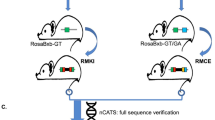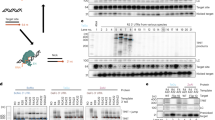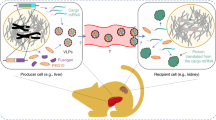Abstract
The development of non-viral gene-transfer technologies that can support stable chromosomal integration and persistent gene expression in vivo is desirable. Here we describe the successful use of transposon technology for the nonhomologous insertion of foreign genes into the genomes of adult mammals using naked DNA. We show that the Sleeping Beauty transposase can efficiently insert transposon DNA into the mouse genome in approximately 5–6% of transfected mouse liver cells. Chromosomal transposition resulted in long-term expression (>5 months) of human blood coagulation factor IX at levels that were therapeutic in a mouse model of haemophilia B. Our results establish DNA-mediated transposition as a new genetic tool for mammals, and provide new strategies to improve existing non-viral and viral vectors for human gene therapy applications.
This is a preview of subscription content, access via your institution
Access options
Subscribe to this journal
Receive 12 print issues and online access
$209.00 per year
only $17.42 per issue
Buy this article
- Purchase on Springer Link
- Instant access to full article PDF
Prices may be subject to local taxes which are calculated during checkout




Similar content being viewed by others
References
Kovesdi, I., Brough, D.E., Bruder, J.T. & Wickham, T.J. Adenoviral vectors for gene transfer. Curr. Opin. Biotechnol. 8, 583–589 (1997).
Latchman, D.S. Herpes simplex virus vectors for gene therapy. Mol. Biotechnol . 2, 179–195 ( 1994).
Gordon, E.M. & Anderson, W.F. Gene therapy using retroviral vectors. Curr. Opin. Biotechnol. 5, 611– 616 (1994).
Naldini, L. Lentiviruses as gene transfer agents for delivery to non-dividing cells. Curr. Opin. Biotechnol. 9, 457–463 (1998).
Rabinowitz, J.E. & Samulski, J. Adeno-associated virus expression systems for gene transfer. Curr. Opin. Biotechnol . 9, 470–475 ( 1998).
Kay, M.A. et al. In vivo gene therapy of hemophilia B: sustained partial correction in factor IX-deficient dogs. Science 262, 117–119 (1993).
Miao, C.H. et al. The kinetics of rAAV integration in the liver. Nature Genet. 19, 13–15 ( 1998).
Snyder, R.O. et al. Correction of hemophilia B in canine and murine models using recombinant adeno-associated viral vectors. Nature Med. 5, 64–70 (1999).
Nakai, H., Iwaki, Y., Kay, M.A. & Couto, L.B. Isolation of recombinant adeno-associated virus vector-cellular DNA junctions from mouse liver. J. Virol. 73, 5438–5447 (1999).
Park, F., Ohashi, K., Chiu, W., Naldini, L. & Kay, M.A. Efficient lentiviral transduction of liver requires cell cycling in vivo. Nature Genet. 24, 49–52 (2000).
Zhu, J. et al. Characterization of replication-competent adenoviral isolates from large-scale production of a recombinant adenoviral vector. Hum. Gene Ther. 10, 113–121 ( 1999).
Yang, Y., Li, Q., Ertl, H.C. & Wilson, J.M. Cellular and humoral immune responses to viral antigens create barriers to lung-directed gene therapy with recombinant adenoviruses. J. Virol. 69, 2004–2015 (1995).
Kay, M.A. et al. Transient immunomodulation with anti-CD40 ligand antibody and CTLA4Ig enhances persistence and secondary adenovirus-mediated gene transfer into mouse liver. Proc. Natl Acad. Sci. USA 94, 4684–4691 (1997).
Hernandez, Y.J. et al. Latent adeno-associated virus infection elicits humoral but not cell-mediated immune responses in a nonhuman primate model. J. Virol. 73, 8549–8558 (1999).
Liu, F., Song, Y.K. & Liu, D. Hydrodynamics-based transfection in animals by systemic administration of plasmid DNA. Gene Ther. 6, 1258– 1266 (1999).
Zhang, G., Budker, V. & Wolff, J.A. High levels of foreign gene expression in hepatocytes after tail vein injections of naked plasmid DNA. Hum. Gene Ther . 10, 1735–1737 ( 1999).
Yew, N.S. et al. Optimization of plasmid vectors for high-level expression in lung epithelial cells. Hum. Gene Ther. 8, 575–584 (1997).
Wolff, J.A. et al. Direct gene transfer into mouse muscle in vivo. Science 247, 1465–1468 ( 1990).
Choate, K.A. & Khavari, P.A. Direct cutaneous gene delivery in a human genetic skin disease. Hum. Gene Ther. 8, 1659–1665 (1997).
Li, K., Welikson, R.E., Vikstrom, K.L. & Leinwand, L.A. Direct gene transfer into the mouse heart. J. Mol. Cell. Cardiol . 29, 1499–1504 ( 1997).
Alino, S.F. et al. Expression of human α-1-antitrypsin in mouse after in vivo gene transfer to hepatocytes by small liposomes. Biochem. Biophys. Res. Comm. 204, 1023–1030 (1994).
Caplen, N.J. et al. Liposome mediated CFTR gene transfer to the nasal epithelium of patients with cystic fibrosis. Nature Med. 1, 39–46 (1995).
Mumper, R.J. et al. Polyvinyl derivatives as novel interactive polymers for controlled gene delivery to muscle. Pharm. Res. 13, 701–709 (1996).
Perales, J.C., Ferkol, T., Molas, M. & Hanson, R.W. An evaluation of receptor-mediated gene transfer using synthetic DNA-ligand complexes. Eur. J. Biochem. 226, 255–266 (1994).
Plasterk, R.H.A. The Tc1/mariner transposon family. Curr. Top. Microbiol. Immunol . 204, 125–143 ( 1996).
Lampe, D.J., Churchill, M.E.A. & Robertson, H.M. A purified mariner transposase is sufficient to mediate transposition in vitro. EMBO J. 15, 5470 –5479 (1996).
Vos, J.C., De Baere, I. & Plasterk, R.H.A. Transposase is the only nematode protein required for in vitro transposition of Tc1. Genes Dev. 10, 755–761 (1996).
Coates, C.J., Jasinskiene, N., Miyashiro, L. & James, A.A. Mariner transposition and transformation of the yellow fever mosquito, Aedes aegypti. Proc. Natl Acad. Sci. USA 95, 3748 –3751 (1998).
Raz, E., van Luenen, H.G., Schaerringer, B. & Plasterk, R.H.A. Transposition of the nematode Caenorhabditis elegans Tc3 element in the zebrafish Danio rerio. Curr. Biol. 8, 82– 88 (1998).
Sherman, A. et al. Transposition of the Drosophila element mariner into the chicken germ line. Nature Biotechnol. 16, 1013– 1017 (1998).
Ivics, Z., Hackett, P.B., Plasterk, R.H. & Izsvak, Z. Molecular reconstruction of Sleeping Beauty, a Tc1-like transposon from fish, and its transposition in human cells. Cell 91, 501–510 (1997).
Luo, G., Ivics, Z., Izsvak, Z. & Bradley, A. Chromosomal transposition of a Tc1/mariner-like element in mouse embryonic stem cells. Proc. Natl Acad. Sci. USA 95, 10769–10773 (1998).
Lohe, A.R., Aguiar, D.D. & Hartl, D.L. Mutations in the mariner transposase: the D,D(35)E consensus sequence is nonfunctional. Proc. Natl Acad. Sci. USA 94, 1293–1297 ( 1997).
Kafri, T., Blomer, U., Peterson, D.A., Gage, F.H. & Verma, I.M. Sustained expression of genes delivered directly into liver and muscle by lentiviral vectors. Nature Genet . 17, 314–317 ( 1997).
Koeberl, D.D., Alexander, I.E., Halbert, C.L., Russell, D.W. & Miller, A.D. Persistent expression of human clotting factor IX from mouse liver after intravenous injection of adeno-associated virus vectors. Proc. Natl Acad. Sci. USA 94, 1426–1431 (1997).
Xiao, W. et al. Adeno-associated virus as a vector for liver-directed gene therapy . J. Virol. 72, 10222–10226 (1998).
Miao, C.H. et al. Non-random transduction of recombinant adeno-associated viral vectors in mouse hepatocytes in vivo: cell cycling is not required for transduction . J. Virol. 74, 3793–3803 (2000).
Reiner, A.P. & Davie, E.W. in The Metabolic and Molecular Basis of Inherited Disease (eds Scriver, C.R., Beaudet, A.L., Sly, W.S. & Valle, D.) (McGraw-Hill, New York, 1995).
Lampe, D.J., Grant, T.E. & Robertson, H.M. Factors affecting transposition of the Himar1 mariner transposon in vitro. Genetics 149, 179– 187 (1998).
Hartl, D.L., Lozovskaya, E.R., Nurminsky, D.I. & Lohe, A.R. What restricts the activity of mariner-like transposable elements? Trends Genet. 13, 197–201 (1997).
Lohe, A.R., Sullivan, D.T. & Hartl, D.L. Subunit interactions in the mariner transposase. Genetics 144, 1087–1095 (1996).
Lin, H.F., Maeda, N., Smithies, O., Straight, D.L. & Stafford, D.W. A coagulation factor IX-deficient mouse model for human hemophilia B. Nature Med. 90, 3962 –3966 (1997).
Kay, M.A. & Fausto, N. Liver regeneration: prospects for therapy based on new technologies. Mol. Med. Today 3, 108–115 (1997).
Zhang, L., Sankar, U., Lampe, D.J., Robertson, H.M. & Graham, F.L. The Himarl mariner transposase cloned in a recombinant adenovirus vector is functional in mammalian cells. Nucleic Acids Res. 26, 3687–3693 ( 1998).
Schouten, G.J., van Luenen, H.G., Verra, N.C., Valerio, D. & Plasterk, R.H. Transposon Tc1 of the nematode Caenorhabditis elegans jumps in human cells. Nucleic Acids Res . 26, 3013–3017 ( 1998).
Plasterk, R.H.A., Izsvak, Z. & Ivics, Z. Resident aliens. Trends Genet. 15, 326–332 (1999).
Kay, M.A., Graham, F., Leland, F. & Woo, S.L.C. Therapeutic serum concentrations of human α-1-antitrypsin after adenoviral-mediated gene transfer into mouse hepatocytes. Hepatology 21, 815–819 (1995).
Walter, J., You, Q., Hagstrom, J.N., Sands, M. & High, K.A. Successful expression of human factor IX following repeat administration of adenoviral vector in mice. Proc. Natl Acad. Sci. USA 93, 3056–3061 ( 1996).
Lieber, A., He, C.-Y., Kirllova, I. & Kay, M.A. Recombinant adenoviruses with large deletions generated by Cre-mediated excision exhibit different biological properties compared with first-generation vectors in vitro and in vivo. J. Virol. 70, 8944– 8960 (1996).
Rutledge, E.A. & Russell, D.W. Adeno-associated virus vector integration junctions. J. Virol. 71, 8429–8436 (1997).
Acknowledgements
We thank H. Nakai and K. Ohashi for their advice and technical assistance, and A. McCaffrey for critical reading of this manuscript. This work was supported by NIH grant DK49022 (M.A.K.). S.R.Y was the recipient of a PHS NRS award T32 GM07270 from NIGMS.
Author information
Authors and Affiliations
Corresponding author
Rights and permissions
About this article
Cite this article
Yant, S., Meuse, L., Chiu, W. et al. Somatic integration and long-term transgene expression in normal and haemophilic mice using a DNA transposon system. Nat Genet 25, 35–41 (2000). https://doi.org/10.1038/75568
Received:
Accepted:
Issue Date:
DOI: https://doi.org/10.1038/75568
This article is cited by
-
Lysyl oxidase-like 3 restrains mitochondrial ferroptosis to promote liver cancer chemoresistance by stabilizing dihydroorotate dehydrogenase
Nature Communications (2023)
-
Sleeping Beauty transposon system for GDNF overexpression of entrapped stem cells in fibrin hydrogel in a rat model of Parkinson’s disease
Drug Delivery and Translational Research (2023)
-
Potent CAR-T cells engineered with Sleeping Beauty transposon vectors display a central memory phenotype
Gene Therapy (2021)
-
CARAMBA: a first-in-human clinical trial with SLAMF7 CAR-T cells prepared by virus-free Sleeping Beauty gene transfer to treat multiple myeloma
Gene Therapy (2021)
-
Sleeping Beauty Transposon-Mediated Asparaginase Gene Delivery by a Nanoparticle Platform
Scientific Reports (2019)



